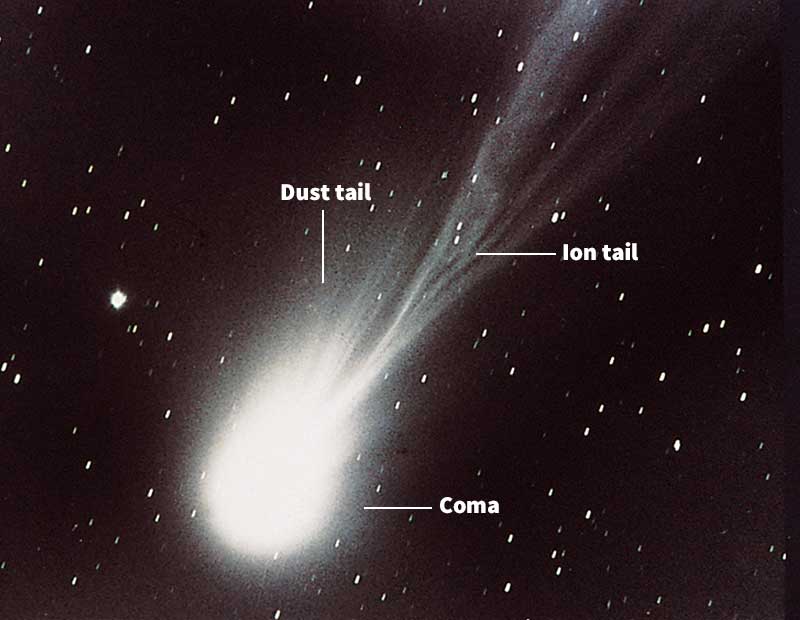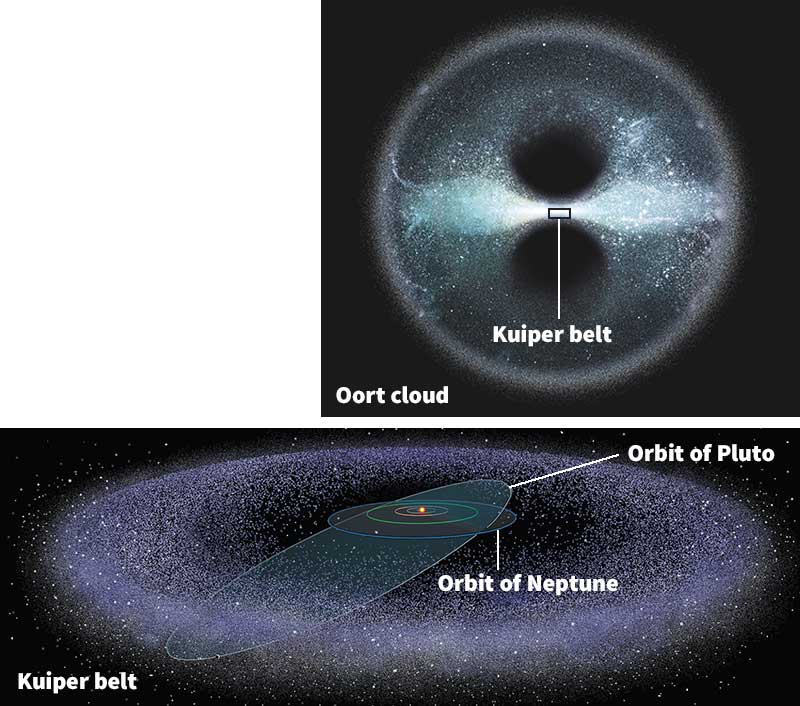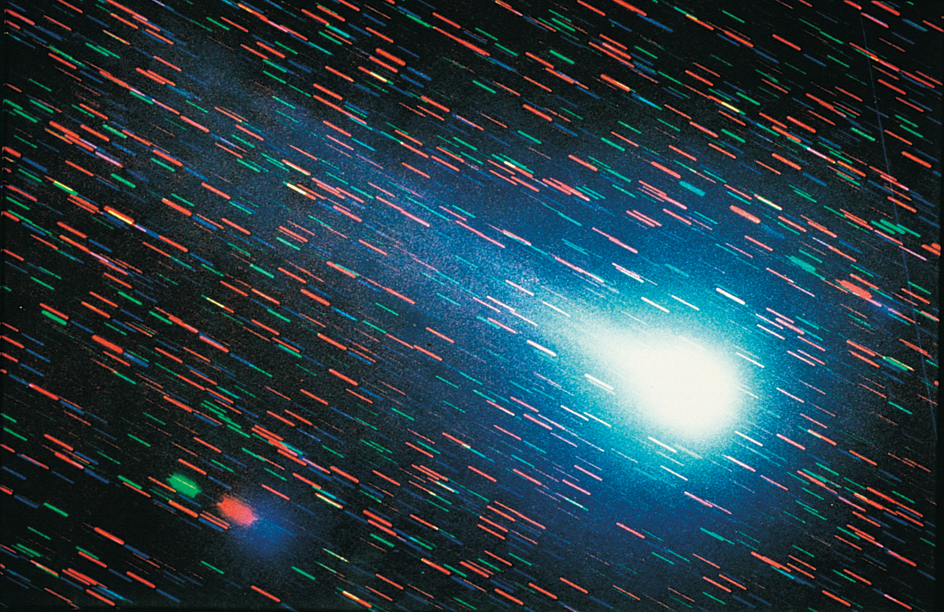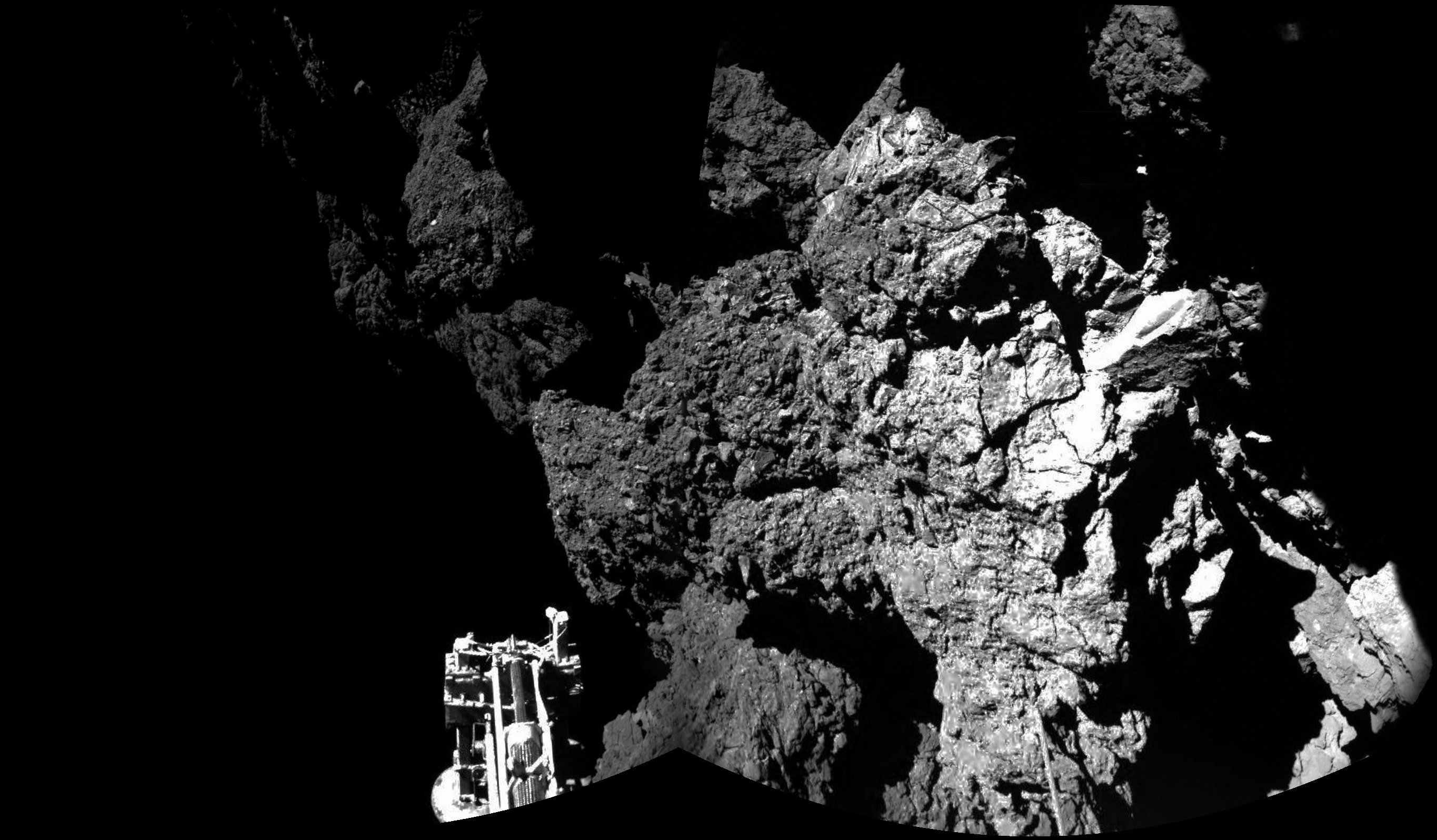Comet, << KOM iht, >> is an icy body that releases gas or dust. Most of the comets that can be seen from Earth travel around the sun in long, oval orbits. A comet has a solid nucleus (core). The nucleus is surrounded by a cloudy atmosphere called the coma and one or two tails. Most comets are too small or too faint to be seen without a telescope. Some comets, however, become visible to the unaided eye for several weeks as they pass close to the sun. We can see comets because the gas and dust in their comas and tails reflect sunlight. Also, the gases release energy absorbed from the sun, causing them to glow.

Astronomers classify comets according to how long they take to orbit the sun. Short-period comets need less than 200 years to complete one orbit. Long-period comets take 200 years or longer.
Astronomers believe that comets are leftover debris from the formation of the outer planets. A collection of gas, ice, rocks, and dust formed the outer planets about 4.6 billion years ago. Some scientists believe that comets originally brought to Earth some of the water and the carbon-based molecules that make up living things.
Parts of a comet.
The nucleus of a comet is a ball of ice and rocky dust particles. It resembles a dirty snowball. The ice consists mainly of frozen water. But it may include other frozen substances, such as ammonia, carbon dioxide, carbon monoxide, and methane. Several comets have split apart for no apparent reason. For this reason, scientists believe the nucleus of some comets may be fragile.
As a comet nears the inner solar system, heat from the sun vaporizes some of the ice on the surface of the nucleus. The comet spews gas and dust particles into space. This gas and dust forms the comet’s coma. Radiation from the sun pushes dust particles away from the coma. These particles form a tail called the dust tail. At the same time, the solar wind converts some of the comet’s gases into ions (charged particles). The solar wind is a flow of high-speed electrically charged particles from the sun. These ions also stream away from the coma, forming an ion tail. Because comet tails are pushed by solar radiation and the solar wind, they always point away from the sun.
Most comets are thought to have a nucleus about 10 miles (16 kilometers) or less across. Some comas can reach diameters of nearly 1 million miles (1.6 million kilometers). Some tails extend to distances of over 300 million miles (480 million kilometers).
The life of a comet.
Scientists think that short-period comets come from a band of objects called the Kuiper belt. The belt lies beyond the orbit of Neptune. The gravitational pull of the outer planets can nudge objects out of the Kuiper belt and into the inner solar system. There, they become active comets. Long-period comets come from the Oort cloud. The Oort cloud is a nearly spherical collection of icy bodies about 5,000 times farther away from the sun than Earth’s orbit. Gravitational interactions with passing stars can cause icy bodies in the Oort cloud to enter the inner solar system and become active comets.

Comets lose ice and dust each time they return to the inner solar system, leaving behind trails of dusty debris. When Earth passes through one of these trails, the debris become meteors that burn up in the atmosphere. Eventually, some comets lose all their ices. They break up and dissipate into clouds of dust. Or they turn into fragile, inactive objects similar to asteroids.
The long, oval-shaped orbits of comets can cross the almost circular orbits of the planets. As a result, comets sometimes collide with planets and their satellites. Many of the impact craters in the solar system were caused by collisions with comets.
Studying comets.
Scientists learned much about comets by studying Halley’s Comet as it passed near Earth in 1986. Five spacecraft flew past the comet. They gathered information about its appearance and chemical composition. Several probes flew close enough to study the nucleus, which is normally concealed by the comet’s coma. The spacecraft found a roughly potato-shaped nucleus measuring about 9 miles (15 kilometers) long. The nucleus contains equal amounts of ice and dust. About 80 percent of the ice is water ice. Frozen carbon monoxide makes up another 15 percent. Much of the remainder is frozen carbon dioxide, methane, and ammonia. Scientists believe that other comets are chemically similar to Halley’s Comet.

Scientists unexpectedly found the nucleus of Halley’s Comet to be dark black. They now believe that the surface of the comet, and perhaps most other comets, is covered with a black crust of dust and rock. The crust covers most of the ice. These comets release gas only when holes in this crust rotate toward the sun, exposing the interior ice to the warming sunlight.
Another comet nucleus that has been seen by spacecraft cameras is that of Comet Borrelly. During a flyby in 2001, the Deep Space 1 spacecraft observed a nucleus about half the size of the nucleus of Halley’s Comet. Borrelly’s nucleus was also potato-shaped and had a dark black surface. Like Halley’s Comet, Comet Borrelly only released gas from small areas where holes in the crust exposed the ice to sunlight.
In 1994, astronomers observed a comet named Shoemaker-Levy 9 crashing into the planet Jupiter. Before it crashed, the comet had split into at least 21 pieces. One of the most active comets seen in more than 400 years was Comet Hale-Bopp. Hale-Bopp came within 122 million miles (197 million kilometers) of Earth in 1997. This was not an especially close approach for a comet. However, Hale-Bopp appeared bright to the unaided eye because its unusually large nucleus gave off a great deal of dust and gas. The nucleus was estimated to be about 18 to 25 miles (30 to 40 kilometers) across.
In 2004, the U.S. spacecraft Stardust passed near the nucleus of Comet Wild 2. The comet was in orbit beyond Neptune, but the gravitational pull of Jupiter brought it into the inner solar system in 1974. Stardust gathered samples from the comet’s coma and returned the particles to Earth in a capsule in 2006. Scientists found that the samples included material that had formed in a hot environment near the sun or other stars. The samples also included organic (carbon-containing) molecules that serve as the chemical building blocks of life.
In 2005, the United States launched the Deep Impact spacecraft to Comet Tempel 1 as it neared the sun. The craft consisted of two smaller probes: an impactor and a flyby craft. In July, the impactor intentionally slammed into the nucleus of the comet. Moments before the collision, the probe took some of the closest photos of the rough, cratered surface of a comet ever made. The flyby craft recorded the crash. The collision vaporized the impactor and produced a brilliant plume of dust. The comet’s brightness temporarily increased by several times. The appearance of the plume suggested that the nucleus’s surface consists of dry, powdery dust grains loosely held together by gravity.
In 2010, the National Aeronautics and Space Administration (NASA) used Deep Impact, renamed EPOXI, to explore Comet Hartley 2. In early 2011, the Stardust spacecraft visited Tempel 1 to see how the comet was altered by the sun’s heat after its close encounter with the sun.
The European Space Agency in 2004 launched the Rosetta spacecraft. It went into orbit around 67P/Comet Churyumov-Gerasimenko in 2014. Rosetta carried a small probe named Philae that landed on the comet’s nucleus in November. In December, scientists reported that water from the comet, analyzed by Rosetta, included more deuterium than does water on Earth. Deuterium is a heavy isotope (form) of hydrogen. The results indicated that Earth’s water did not come from comets similar to this one. 
In the late 2010’s, scientists observed the first two known objects to enter the solar system from interstellar space, the space between the stars. The objects were ‘Oumuamua, discovered in 2017, and 2I/Borisov, discovered in 2019. Both were determined to be comets.
